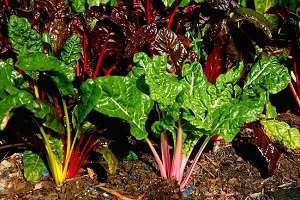It seems that wherever I go, I see Swiss chard. This showy, cool-season plant, sometimes called a “beet without a bottom,” is showing up in the landscape, in mixed containers and in local grocery stores. Is it an ornamental or an edible? It is both. Do you eat it fresh or do you cook it? Again, the answer is both.

It has been almost 20 years since the All-America Selections winner ‘Bright Lights’ Swiss chard showed up on the scene.Swiss chard: highly ornamental and wonderfully edible Swiss chard is known botanically as “Beta vulgaris ssp. vulgaris,” showing it is a leafy beet.
But holy cow! Now you look at a catalogue and you’ll see ‘Bright Lights’ there, but also single colors like ‘Oriole,’ ‘El Dorado,’ ‘Magenta Sunset,’ ‘Ruby Red’ and the bicolored ‘Peppermint.’ The same thing can be found at your grocery store. There are probably three to four varieties to choose from for your culinary artistry needs.
Swiss chard is ready to harvest at baby green – within 30 days – or at mature harvest in 60 days. You may cut the outer leaves when they are smaller and more tender or cut or break them off when they are 12 to 18 inches tall. Like many plants, it seems harvesting lengthens production.
The stalks can be cooked like asparagus. Cut the stems into 2- or 3-inch lengths and simmer in boiling, salted water until tender. The leaves can be cooked or eaten fresh in tossed salads. Or you can simply enjoy the texture and color in the landscape or a styled container.
If you find yourself in the frozen tundra right now, just know that you can use Swiss chard as a fall crop or spring crop. Actually with its heat tolerance, it has become a year-round crop in some areas, where it is grown in succession plantings. Space plants about 6 inches apart. In the garden, this would usually mean rows 18 to 30 inches apart. I think the flower bed is the real location of choice for Swiss chard. Here, you would still use the same 6-inch spacing, but plant in large, informal drifts where you might plant a couple of flats.
Another good way to use ‘Bright Lights’ or your favorite variety in the landscape would be as a pocket planting of seven to nine plants clustered behind pansies or three plants at the center of a large mixed container. Feed the plants a diluted, water-soluble fertilizer every couple of weeks during the growing season.
Here is hoping you have a little Swiss chard for your holiday dinners, but when the garden centers open back up and start bringing in fresh transplants, give them a try in your garden.
Source: uga.edu